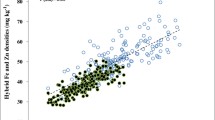Summary
The grain yield and contents of the quantitatively predominant nutritional constituents of barley grain were determined in nine adapted spring barley varieties each grown at seven European locations with three or four replications.
The largest variation in nutritional composition was due to different environmental conditions, but genotypic effects were also present. Interactions between genotype and environment were small. The average protein content at different locations varied from 8.1 to 14.7 per cent of the grain dry matter, and was not simply related to the amount of fertilizer-N applied.
The nutritional composition of the grain was influenced by the grain yield level. The percentage of dietary fiber and protein decreased with increasing grain yield, but some varietal differences which were independent of the grain yield level could be established.
The protein quality depended upon the protein level, as the protein contained more prolamin relatively to non-prolamin protein at high than at low protein levels. A difference between two varieties in the prolamin/non-prolamin ratio was consistent over a wide range of variation in protein content.
Similar content being viewed by others
References
Andersen, A. J., 1977. Effects of fertilizers on barley protein quantity and quality. Cereal Res. Comm. 5 (2): 158–167.
Bruhn, L. C. & R. Djurtoft, 1977. Protease inhibitors in barley. Z. Lebensm. Untersuch.-Forsch. 163: 1–8.
Calvert, C. C., 1975. Nutritional implications of amylose-amylopectin ratio in barley cultivars for rats and swine. (Thesis). Montana State University, Boseman, Montana, USA.
Doll, H., 1972. Variation in protein quantity and quality induced in barley by EMS treatment. In: Induced mutations and plant improvement. IAEA, Vienna, p. 331–342.
Eggum, B. O. & L. D. Campbell, 1979. Nutritional and antinutritional assay. In: Seed protein improvement in cereals and grain legumes. Vol. I. IAEA, Vienna, p. 353–368.
Fischbeck, G., 1963. Untersuchungen über Ausmass, Sicherheit und Ursachen erblicher Unterschiede im Rohproteingehalt der Sommergerste. Z. Acker- und Pflanzenbau 118(4): 321–344.
Hadjichristodoulou, A. & A. Della, 1978. Factors affecting genotypic and environmental variance for crude protein content in cereals. Euphytica 27: 117–126.
Jestin, L., 1978. The protein content of spring barley varieties: genetic variations, fluctuations and interactions with environment. In: B. J. Miflin & M. Zoschke (Eds), Carbohydrate and protein synthesis. Commission of the European Communities. EUR 6043EN, p. 55–60.
Køie, B. & G. Nielsen, 1977. Extraction and separation of hordeins. In: B. J. Miflin & P. R. Shewry (Eds), Techniques for the separation of barley and maize seed protein. Commission of the European Communities, EUR 5687E. p. 25–89.
McCready, R. M., J. Guggolz, V. Silviera & H. S. Owens, 1950. Determination of starch and amylose in vegetables. Anal. Chem. 22: 1156–1158.
Munck, L., 1972. Improvement of nutritional value in cereals. Hereditas 72: 1–128.
Pomeranz, Y., G. S. Robbins, J. T. Gilbertson & G. D. Booth, 1977. Effects of nitrogen fertilization on lysine, threonine and methionine of hulled and hull-less barley cultivars. Cereal Chem. 54(5): 1034–1042.
Rasmusson, D. C. & R. L. Glass, 1967. Estimates of genetic and environmental variability in barley. Crop Sci. 7: 185–188.
Stølen, O. & B. T. Viuf, 1978. Protein production in barley. I. Influences of different growing conditions. Kgl. Vet.-og Landbohøjsk. Årsskr. 1979, p. 64–74.
Torp, J., 1979. Relations between production of starch and percentage, quality and yield of protein in barley. Z. Acker- und Pflanzenbau 148: 367–377.
Torp, J., 1980. Variation in the concentration of major carbohydrates in the grain of some spring barleys. J. Sci. Food Agric. 31: 1354–1360.
Whitehouse, R. N. H., 1968. Barley breeding at Cambridge. Rep. Pl. Breed. Inst. 1968, p. 6–29.
Whitehouse, R. N. H., 1973. The potential of cereal grain crops for protein production. In: J. G. W. Jones (Ed.), The biological efficiency of protein production. University Press, Cambridge, p. 83–99.
Wolf, M. J., E. H. Melvin, W. J. Garcia, R. J. Dimler & W. F. Kwolek, 1970. Amylose determination in dimethyl sulfoxide extracts of maize. Cereal Chem. 47: 437–446.
Wolf, M. J., U. Khoo & G. E. Inglett, 1977. Partial digestibility of cooked amylomaize starch in humans and mice. Staerke 12: 401–436.
Woodham, A. A., S. Savić & W. R. Hepburn, 1972. Evaluation of barley as a source of protein for chicks. J. Sci. Food Agric. 23: 1045–1054.
Author information
Authors and Affiliations
Rights and permissions
About this article
Cite this article
Torp, J., Doll, H. & Haahr, V. Genotypic and environmental influence upon the nutritional composition of barley grain. Euphytica 30, 719–728 (1981). https://doi.org/10.1007/BF00038800
Received:
Issue Date:
DOI: https://doi.org/10.1007/BF00038800



